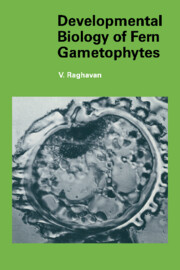Book contents
- Frontmatter
- Contents
- Preface
- Abbreviations
- 1 Introduction
- PART I THE BEGINNING
- PART II GROWTH AND MATURATION
- 6 Developmental physiology of gametophytes – the germ filament
- 7 Developmental physiology of gametophytes – induction of planar growth
- 8 Role of protein and nucleic acid synthesis in planar growth
- 9 Vegetative and reconstitutive growth of gametophytes
- PART III REPRODUCTIVE STRATEGIES
- PART IV DEVELOPMENTAL OPTIONS
- References
- Author index
- Subject index
9 - Vegetative and reconstitutive growth of gametophytes
Published online by Cambridge University Press: 11 September 2009
- Frontmatter
- Contents
- Preface
- Abbreviations
- 1 Introduction
- PART I THE BEGINNING
- PART II GROWTH AND MATURATION
- 6 Developmental physiology of gametophytes – the germ filament
- 7 Developmental physiology of gametophytes – induction of planar growth
- 8 Role of protein and nucleic acid synthesis in planar growth
- 9 Vegetative and reconstitutive growth of gametophytes
- PART III REPRODUCTIVE STRATEGIES
- PART IV DEVELOPMENTAL OPTIONS
- References
- Author index
- Subject index
Summary
With the description of the landmark stages in the early development of fern gametophytes behind us, we are now in a position to consider the factors that regulate their growth and maturation. Studies in this area have been largely aided by the ease with which gametophytes of homosporous ferns can be raised from spores in large numbers under aseptic conditions. For the most part of its growth, the gametophyte is only one cell layer thick, a property which makes determination of cell numbers a less formidable task; the structural simplicity of the gametophyte also makes it possible to study a range of morphological expression of cells which seem to possess unlimited potentialities. It is, therefore, no wonder that the effects of a staggering variety of chemicals on the growth of gametophytes of a number of ferns have been tested, with a view to determine the optimum nutrient or chemical environment for their growth. Surprisingly, in these studies there were relatively few examinations for the changes of biochemical constituents or hormone levels during growth. This was because it is so much easier to follow growth of gametophytes in a given nutrient milieu in terms of a few growth parameters like increase in surface area, increase in cell number or change in the dimensionality of growth (such as from filamentous to planar) than process the material for arduous biochemical determinations.
- Type
- Chapter
- Information
- Developmental Biology of Fern Gametophytes , pp. 168 - 196Publisher: Cambridge University PressPrint publication year: 1989

